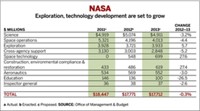Advertisement
Grab your lab coat. Let's get started
Welcome!
Welcome!
Create an account below to get 6 C&EN articles per month, receive newsletters and more - all free.
It seems this is your first time logging in online. Please enter the following information to continue.
As an ACS member you automatically get access to this site. All we need is few more details to create your reading experience.
Not you? Sign in with a different account.
Not you? Sign in with a different account.
ERROR 1
ERROR 1
ERROR 2
ERROR 2
ERROR 2
ERROR 2
ERROR 2
Password and Confirm password must match.
If you have an ACS member number, please enter it here so we can link this account to your membership. (optional)
ERROR 2
ACS values your privacy. By submitting your information, you are gaining access to C&EN and subscribing to our weekly newsletter. We use the information you provide to make your reading experience better, and we will never sell your data to third party members.
Environment
NASA: Support To Enable Future Asteroid Mission
by Susan R. Morrissey
April 22, 2013
| A version of this story appeared in
Volume 91, Issue 16

President Obama is proposing a slight drop in funds for the National Aeronautics & Space Administration in fiscal 2014 as compared with 2012. The $17.7 billion request—down 0.3% from 2012—reflects the fiscal realities while better aligning the agency’s activities to meet the President’s challenge of sending humans to an asteroid by 2025 and to Mars in the 2030s.
As a result, the proposed budget includes cuts to areas such as planetary science and astrophysics to balance requested increases in other areas such as exploration and space technology. NASA’s education funding is also being cut, but this is due to a proposed consolidation of science, technology, engineering, and mathematics education efforts across the federal government.
“The President’s fiscal year 2014 budget ensures that we, the U.S., remain the world’s leader in space exploration and scientific discovery for years to come, while making critical advances in aerospace and aeronautics to benefit the American people,” said NASA Administrator Charles F. Bolden Jr. at the agency’s budget briefing.
Under the proposed plan, NASA would fully fund efforts to develop new spacecraft both in-house and by third parties. The budget provides $2.7 billion to develop its own next-generation deep-space crew capsule and heavy-lift rocket. And $821 million is provided to support NASA-sponsored commercial efforts to develop transports to the International Space Station.
The agency also announced it will initiate planning for a human asteroid mission, which is targeted to take place before 2025. In addition, the budget provides funds for another Mars rover. For ongoing activities, the budget maintains support for rovers and orbiters already on or near the Red Planet. The budget also supports the MAVEN mission, which is set to launch in November to study the martian upper atmosphere, and the InSight mission, a Mars rover that is scheduled to launch in 2016 to probe deeper into martian soil.
To better study our own plant, the President provides $1.8 billion in 2014. This funding will maintain U.S. weather and climate-change modeling capabilities and will support R&D, airborne science, and technology development. The 2014 budget also slates $658 million to keep the James Webb Space Telescope on schedule to launch in 2018.
MORE ON THIS STORY
- - Science Funding
- - NSF: Basic Science Set To Grow
- - NIH: Funding Remains Flat, But Offers Relief From Sequestration
- - Defense: Cuts Hit Systems Development
- - DHS: Huge Jump To Support New Biocontainment Lab
- - Energy: Renewable Energy Set For Boost
- - NASA: Support To Enable Future Asteroid Mission
- - Commerce: NIST, NOAA Get Budget Hikes
- - Agriculture: Competitive Research Funds Set To Rise
- - EPA: Research On Contaminated Sites Scaled Back
- - Interagency Initiatives: Education Reshuffled, Climate Up, Nanotech Reduced
- - FDA User Fees Continue To Climb




Join the conversation
Contact the reporter
Submit a Letter to the Editor for publication
Engage with us on Twitter